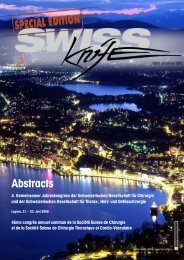Anorectal Manometry in 3D NEW! - Swiss-knife.org
Anorectal Manometry in 3D NEW! - Swiss-knife.org
Anorectal Manometry in 3D NEW! - Swiss-knife.org
Create successful ePaper yourself
Turn your PDF publications into a flip-book with our unique Google optimized e-Paper software.
35.7<br />
Expression of melanoma-associated antigens (MAGE) <strong>in</strong> stage I NSCLCs<br />
C. Sadowski-Cron 1 , C. Ruiz 1 , I. Zlobec 1 , I. Ackermann 1 , M. Gugger 2 , M. Naef 2 , R. A. Schmid 2 , P. Zajac 1 ,<br />
G. Spagnoli 1 , L. Bubendorf 1 , D. Lard<strong>in</strong>ois 1 ( 1 Basel, 2 Berne)<br />
Objective: The classical prognostic factors for operable non-small cell lung cancers (NSCLC) are pTNstage<br />
and grade. Despite of these established prognostic factors, a considerable fraction of early-stage<br />
patients do relapse. Therefore, new prognostic and predictive molecular markers are needed to identify<br />
patients who could benefit from adjuvant chemotherapy or targeted therapies. Tumor associated antigens<br />
(TAA) of the Cancer/testis (C/T) family have been used <strong>in</strong> advanced NSCLC as targets for specific<br />
immunotherapy. Nevertheless, comprehensive data of their expression and prognostic relevance <strong>in</strong><br />
early-stage NSCLC are not yet available. Here, we analyzed the prevalence and the prognostic significance<br />
of the C/T family members MAGE-A and NY-ESO <strong>in</strong> a multi-<strong>in</strong>stitutional study of stage I lung<br />
cancer patients.<br />
Methods: We constructed a tissue microarray from 519 surgical specimens from stage I NSCLC cancer<br />
patients, who underwent surgery either at the University Hospital Basel or at the Inselspital Bern.<br />
Comprehensive histopathological and cl<strong>in</strong>ical data were collected, <strong>in</strong>clud<strong>in</strong>g follow-up on overall and<br />
tumor-specific survival. Semi-quantitative expression of the MAGE-A and of the NY-ESO prote<strong>in</strong>s was<br />
determ<strong>in</strong>ed by immunohistochemistry. We analyzed the association of these markers with standard<br />
morphological parameters and the proliferation marker Ki67 on consecutive TMA sections.<br />
Results: 44% of NSCLC stage I tumors expressed either MAGE-A or NY-ESO prote<strong>in</strong>. Squamous cell carc<strong>in</strong>omas<br />
(SqCC) showed the highest prevalence of MAGE-A prote<strong>in</strong> expression (58%, 131 of 223), and<br />
only <strong>in</strong> these tumors, the expression of both C/Ts correlated significantly (p
















